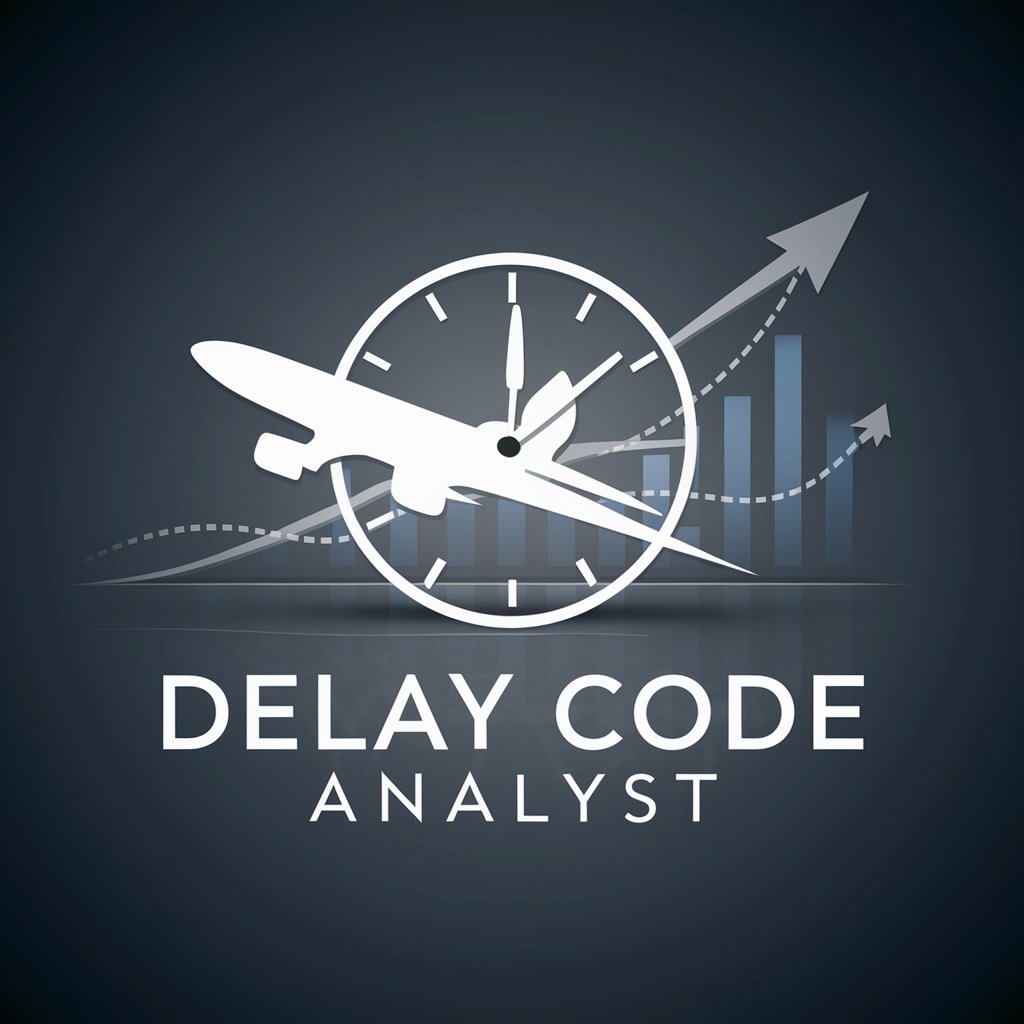
Delay Code Analyst - Flight Delay Analysis

Welcome! Let's analyze your flight delays with precision.
Streamlining delay analysis with AI
Analyze the flight delay using the provided parameters:
Calculate the Estimated Time of Departure (ETD) based on:
Identify and justify the IATA delay codes for the following delay:
Determine if the flight was delayed and by how many minutes based on:
Get Embed Code
Introduction to Delay Code Analyst
Delay Code Analyst is a specialized tool designed for aviation professionals, particularly in the field of airline operations and airport management. Its primary purpose is to analyze flight delays using specific parameters such as Scheduled Time of Arrival (STA), Actual Time of Arrival (ATA), Scheduled Time of Departure (STD), Actual Time of Departure (ATD), and Total Turnaround Time (TTM). By comparing these parameters, the tool determines if a flight is delayed and by how much. Furthermore, it calculates the Estimated Time of Departure (ETD) and assigns appropriate IATA delay codes, offering insights into the reasons behind delays. An example scenario includes analyzing a flight that arrived late due to adverse weather conditions and determining the impact on subsequent departures, including assigning delay codes for weather and the resultant aircraft rotation delay. Powered by ChatGPT-4o。

Main Functions of Delay Code Analyst
Delay Detection and Calculation
Example
Identifying that a flight departed 30 minutes later than its scheduled departure due to late arrival of the inbound aircraft.
Scenario
This function is crucial when a flight's ATD is later than its STD, indicating a delay. The tool calculates the delay duration and its impact on the flight schedule.
Estimated Time of Departure Calculation
Example
Calculating an ETD for a delayed flight by adding the Total Turnaround Time to the Actual Time of Arrival.
Scenario
In scenarios where quick turnaround is essential, calculating an accurate ETD helps in minimizing the delay's impact on the flight schedule and passenger connections.
IATA Delay Codes Assignment
Example
Assigning code 93 (Aircraft Rotation) due to a delay caused by the late arrival of the incoming aircraft, affecting its departure for the next flight.
Scenario
This function aids in pinpointing the exact reasons for delays, facilitating better management and mitigation strategies, and is essential for reporting purposes.
Ideal Users of Delay Code Analyst Services
Airline Operations Managers
These professionals benefit from understanding the intricacies of flight delays to manage schedules effectively, reduce downtime, and improve passenger satisfaction. The detailed delay analysis helps in decision-making regarding resource allocation and operational adjustments.
Airport Ground Handling Managers
For those responsible for the coordination of ground services, understanding delay causes is vital. It enables effective planning for ground handling activities, including refueling, catering, and baggage handling, ensuring a swift turnaround and minimizing further delays.
Airline Customer Service Representatives
Customer service teams can use detailed delay analysis to provide accurate information to passengers, manage expectations, and facilitate alternative arrangements. Understanding the reasons for delays helps in personalizing communication and improving the overall customer experience.

How to Use Delay Code Analyst
1
Start by visiting yeschat.ai to access a free trial without needing to log in, bypassing the requirement for ChatGPT Plus.
2
Enter specific flight details including Scheduled Time of Arrival (STA), Actual Time of Arrival (ATA), Scheduled Time of Departure (STD), Actual Time of Departure (ATD), and Total Turnaround Time (TTM) to initiate analysis.
3
Review the generated Estimated Time of Departure (ETD) and compare it against the Scheduled Time of Departure (STD) to identify potential delays.
4
Use the provided delay analysis to assign appropriate IATA delay codes, considering whether ETD is greater or less than STD for accurate categorization.
5
Leverage the tool's insights for operational planning, delay mitigation strategies, and improving flight punctuality through informed decision-making.
Try other advanced and practical GPTs
10-k link
Instant SEC filings at your fingertips, powered by AI.

Grammar Guru
Enhance your writing with AI

Relay Guide
Streamline Compliance with AI

文章润色
Polish Your Text with AI Power

Electronic Repairer, Substation, Relay Assistant
AI-powered Electrical Fault Resolution

No More Delay
Harness AI to conquer procrastination

Chart Maker
Turn Data into Visual Stories

harambe's spirit
Engage with the playful, witty AI.

Spirit Guide
Discover Your Spirit Animal with AI

Generous Spirit
Empowering Philanthropy with AI

Nature Spirit
Unveiling Nature's Mysteries with AI

Spirit Airlines
Navigate Air Travel Seamlessly

FAQs About Delay Code Analyst
What is Delay Code Analyst?
Delay Code Analyst is an AI-powered tool designed to analyze flight delays using specific parameters like STA, ATA, STD, ATD, and TTM, assigning IATA delay codes accordingly.
How can Delay Code Analyst benefit airline operations?
It helps in identifying the root causes of delays, improving operational efficiency, and enhancing customer satisfaction by enabling airlines to proactively manage and mitigate flight delays.
Can Delay Code Analyst predict future flight delays?
While it primarily analyzes existing delays, the insights gained can inform operational adjustments that may reduce the likelihood of future delays.
Do I need aviation knowledge to use Delay Code Analyst?
Basic familiarity with aviation terminology and operations enhances the user experience, but the tool is designed with an intuitive interface for users at all levels of expertise.
How does Delay Code Analyst handle ambiguous or incomplete flight data?
It employs AI algorithms to make educated guesses based on available data, noting assumptions made during the analysis to provide as accurate an assessment as possible.





